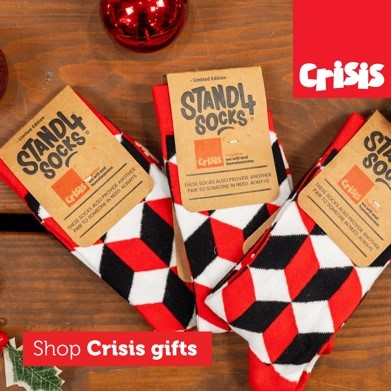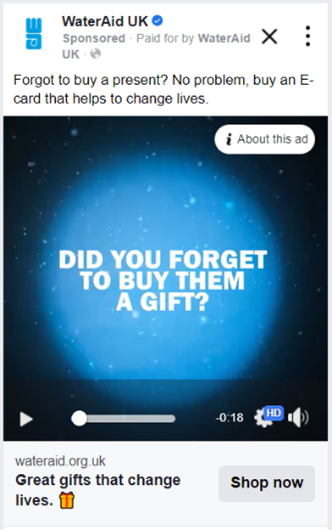By Senior Digital Account Director Megan Ashdown and Programmatic Account Director John Downs
It’s a position no one wants to be in. But once again, we are facing a Christmas shrouded by the ongoing cost-of-living crisis, and it’s worse than last year.
As we dive headfirst into peak season – the topline stats aren’t positive for marketers; most consumers plan to reduce their Christmas spending, with 64% stating that they would be cutting back on Christmas spending this year – it doesn’t make for encouraging ROI forecasts. [1]
But there is hope.
Consumers are moving towards thoughtful gifting. 64% believe receiving meaningful rather than expensive presents is better, and 47% of consumers say they plan to buy thoughtful gifts for friends and family this year. [2]
Enter please – Charity Gifting.
Charities are uniquely positioned to play on consumer sentiment this year regarding gifting. More than ever, products can be propositioned as meaningful and thoughtful gifts. Many charities are already utilising this, with products such as “Secret Santa” from Action for Children and “Crisis Stocking” from Crisis playing on the “give a gift” aspect to their donations – actively providing virtual gift cards and certificates to gift the donation in another’s name.
Not only can donations be actively re-positioned as gifts, but gifting from charities (e)commerce can also drive increased revenue for NGOs. In 2022, Oxfam’s high street shops reported a 40% increase in shop revenue the week before Christmas [3] – and with 67% of UK adults stating they would be happy to receive a second-hand or refurbished gift (and 33% of these saying that the proceeds going to a good cause is a key factor for second-hand gifting), it’s clear this is a space that is growing and can be capitalised on by the Third Sector. [4]
With all the above in mind, it’s more important than ever to remind ourselves of the Google/Ipsos statistic that 70% of a campaign’s success is determined by the creative[5]. We know that the season of giving is a critical time to construct our ads to maximise their impact – and ultimately encourage our audiences to purchase a charity gift – but is there a magic formula to achieve this? Yes and No.
We know that creative is hugely subjective, and everyone’s perception of what makes a good creative varies massively, so it’s impossible to produce a one-size-fits-all masterpiece. But that’s not to say a Christmas creative can’t be done well. John Lewis is a key example of effectively utilising a highly impactful and hotly anticipated Christmas ad year after year, eliciting a powerful emotional response, driving resultant brand affinity and crucial sales. It speaks volumes that even John Lewis, in 2023, presents the initial focus of the ad on a meaningful present found at an antique store. Even our largest retailers now nod to second-hand in these tricky economic times.
Taking a closer – more objective – look at John Lewis’ secret sauce however, we can find some key ingredients that can now be measured ‘objectively’ and apply this to Charity gifting in 2023.
1. Engagement – a good ad is attention-grabbing. A recent example includes Action for Children’s Secret Santa creative, which features animated falling snow against their bold red background – immediately capturing the audience’s attention.

2. Cognitive Demand – A cluttered ad with mixed or multiple messages or focuses will require too much ‘brain power’ to compute. On the flip side, an ad that is too simple may not spark the formation of any sort of neural or emotional pathways. The familiar gift of socks is evident in Crisis’s Christmas Shop ad below and provides a clear CTA, hitting the balance perfectly.

3. Clarity – Is it clear what the ad’s message is and how it’s meant to make the viewer feel? Brooke’s message is clear and concise in a series of short, animated frames, and the audience can immediately understand what is being advertised – and by whom.

4. Focus – an ad has less than 1.7 seconds to capture attention. WaterAid created an attention-grabbing ad with a high-impact 1st frame, encouraging the user to watch on, engage, and purchase.

On top of these key factors, we can play on consumer sentiment, which constantly changes with seasonal and economic influences. For example, this year, 46% of consumers want to see Christmas advertising that reminds them of better times[6], and 55% of people are looking to spend between £10 – £49.99 on a gift. So, on top of our fundamentals, this would be a consideration when concepting both creative and messaging. [7]
Despite another bleak marketing outlook this Christmas – there is a way forwards… but it’s largely hinging on effective product propositions AND a solid creative strategy.
Unsure of where to start? The Kite Factory’s specialist creative versioning department, Kite Studio, comes armed with recommendations to upgrade your creative. Alongside this, they have access to groundbreaking software that can scan your ad for digital attention and effectiveness, making people truly sit up and notice your campaigns this year. By combining art and science across your creative, we can help your campaigns fly this Christmas.
[1] https://ipa.co.uk/news/christmas-amidst-the-crunch-2
[2] https://www.ebayads.com/wp-content/uploads/2023/09/ebay_ads_christmas_2023_F-1.pdf
[3] https://www.thirdsector.co.uk/charity-shop-income-15-per-cent-year/fundraising/article/1825032
[4] https://ipa.co.uk/news/christmas-amidst-the-crunch-2
[5] https://www.thinkwithgoogle.com/intl/en-gb/marketing-strategies/automation/from-manual-ios-to-programmatic-buying-best-practices
[6]https://ipa.co.uk/news/christmas-amidst-the-crunch-2
[7] https://ipa.co.uk/news/christmas-amidst-the-crunch-2
